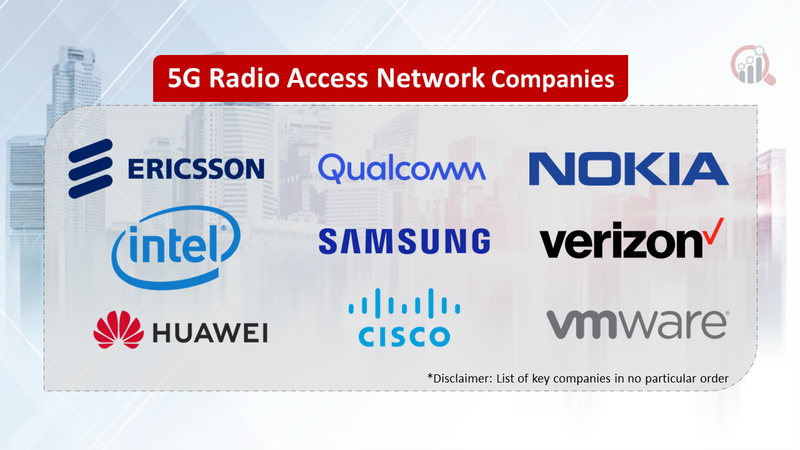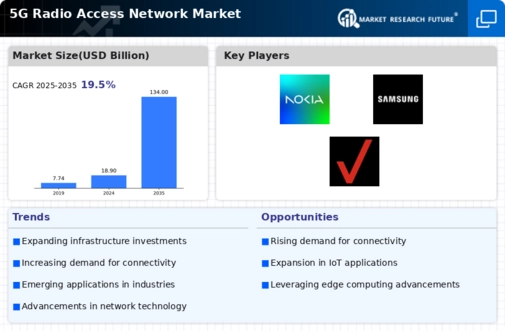Top Industry Leaders in the 5G Radio Access Network Market

Competitive Landscape of the 5G Radio Access Network Market:
The 5G Radio Access Network (RAN) market is exploding, propelled by the thirst for ubiquitous high-speed connectivity and transformative applications. It forms the lifeblood of 5G infrastructure, connecting devices to the core network. The market promises fierce competition and strategic maneuvering among established players and ambitious newcomers.
Key Players:
- Telefonaktiebolaget LM Ericsson
- Qualcomm Technologies, Inc.
- Nokia
- Intel Corporation
- Samsung
- Verizon
- Cisco Systems, Inc.
- Huawei Technologies Co., Ltd.
- VMware, Inc.
- Rakuten Symphony Singapore Pte. Ltd
Factors for Market Share Analysis:
- Portfolio Breadth and Technology Innovation: Offering a comprehensive range of 5G RAN equipment, including macro, small cell, and indoor solutions, is crucial. Continuous R&D investment in network performance, latency reduction, and energy efficiency drives market share gains.
- Deployment Flexibility and Network Optimization: Adapting to diverse network requirements with flexible deployment options, from centralized to distributed architectures, is key. Optimizing network performance through automation and AI-powered tools enhances market competitiveness.
- Cost-Effectiveness and Pricing Strategies: Competitive pricing models attract cost-conscious operators, especially in emerging markets. Offering financing options and service bundles can further secure market share.
- Compliance with Open RAN Standards: Aligned with the Open RAN movement, promoting greater vendor interoperability and network flexibility, strengthens market position. Collaboration with ecosystem partners adds value and attracts customers.
- Global Reach and Presence: A strong footprint across diverse regions with established sales and support networks provides a distinct advantage. Expanding services and partnerships in developing markets fosters market share growth.
New and Emerging Companies:
Several smaller players are making waves in the 5G RAN market, challenging established players with innovative solutions and disruptive approaches. Notable examples include:
- Ciena: Specializing in high-bandwidth optical networking solutions, Ciena is making inroads into 5G fronthaul and midhaul networks, offering efficient data transport between RAN and core.
- JMA Wireless: This American company focuses on small cell solutions for dense urban deployments, catering to the growing demand for high-capacity networks in crowded areas.
- Airspan Networks: A British firm, Airspan offers open RAN software and base stations, promoting vendor neutrality and network flexibility, addressing concerns about vendor lock-in in traditional RAN deployments.
Current Company Investment Trends:
- Cloud RAN: Investments in cloud-native RAN solutions are surging, enabling centralized management, improved scalability, and faster network deployments.
- Open RAN Ecosystem: Collaboration and partnerships within the Open RAN ecosystem are accelerating to drive standardization, interoperability, and cost optimization.
- Software-Defined Networking (SDN): Integrating SDN capabilities into RAN solutions enhances network programmability, automation, and real-time traffic management.
- AI and Machine Learning: Utilizing AI and ML for network optimization, anomaly detection, and predictive maintenance is becoming a priority for improving network performance and efficiency.
- Private 5G Networks: Investments in private 5G network solutions for enterprises and industries are rising, creating lucrative new market segments for RAN vendors.
Latest Company Updates:
Dec 21, 2023, Ongoing global supply chain disruptions continue to pose challenges for 5G RAN equipment availability and deployment timelines.
Nov 10, 2023, Ensuring the security and privacy of 5G networks remains a critical concern, with governments and operators implementing stricter regulations and security measures.
Oct 5, 2023, Access to adequate spectrum resources for 5G deployment varies across regions, impacting network capacity and coverage.

